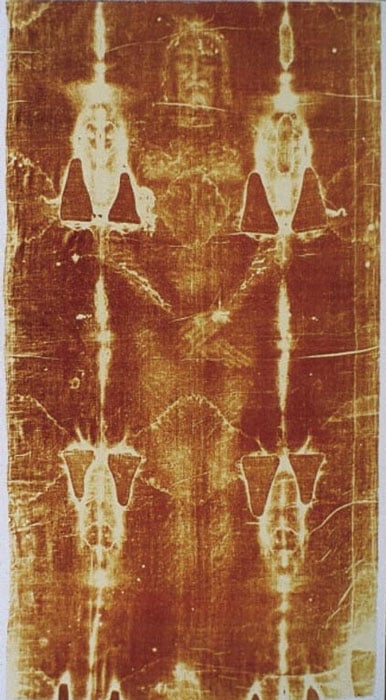
Every Curator’s Dream? 2000-Year-Old Mummy Shroud Discovered at the National Museum of Scotland
Curators at the National Museum of Scotland have made an exceptional discovery inside a World War II service envelope with a hand-written note. The writing distinguishes the contents, a remarkably preserved mummy shroud, as being from an ancient Egyptian tomb originally built around 1290 BC. The package had been forgotten in the museum’s storage since the mid-1940s.
Ancient Textile Described as a “Curator’s Dream”
The shroud, which dates to the 9 BC, was discovered during "an in-depth assessment" of Egyptian collections and it is only one of the many objects from this tomb which are in the museum’s collections. Conservators gently humidified it in order for the fibers to become less dry and brittle. This helped experts to cautiously unfold the shroud, a procedure that lasted nearly 24 hours. A hieroglyphic inscription on the shroud divulged the owner’s identity: the son of the Roman-era high-official Montsuef and his wife Tanuat. Dr. Margaret Maitland, senior curator of ancient Mediterranean collections, told BBC:
"To discover an object of this importance in our collections, and in such good condition, is a curator's dream. Before we were able to unfold the textile, tantalising glimpses of colourful painted details suggested that it might be a mummy shroud, but none of us could have imagined the remarkable figure that would greet us when we were finally able to unroll it. The shroud is a very rare object in superb condition and is executed in a highly-unusual artistic style, suggestive of Roman period Egyptian art, yet still very distinctive."
- The Shroud of Turin: Controversial Cloth Defies Explanation as Study Shows it Has DNA From Around the World
- 2,000-Year-Old Paracas Shroud Returns Home

Researchers examining the shroud. (National Museum of Scotland)
Other Remarkable Shrouds
Of course, this is not the first time an extraordinary shroud is found in great shape. A rare and exquisite funeral shroud dating back 2,000 years to the ancient Paracas culture of Peru was discovered on the Paracas Peninsula in the 1920s. The magnificent textile was described as uniquely complex, with more than 80 hues of blue, green, yellow and red woven into a pattern of 32 frames.
Yet the most notable and famous archaeological story involving a shroud consists of the notorious Shroud of Turin. Believed by many to be the burial cloth of Jesus of Nazareth, but held only as a religious article of historical significance by skeptics, the Shroud of Turin has captivated scholars and scientists alike due to its mysterious nature. What’s even stranger with this case is that most recent studies and DNA tests add more fuel to the fire instead of solving the puzzle.
- Archaeologists Are Surprised to Find a 2,500-Year-Old Cannabis Burial Shroud Found in China
- The Shroud of Oviedo: A Legendary Cloth Connected to the Death of Jesus

The renowned Shroud of Turin, religious relic and mysterious artifact. (Public Domain)
Newly Found Shroud Comes from a Roman-Era Burial
Experts claim that the mummy shroud found in the National Museum of Scotland comes from a Roman-era burial in a tomb originally built about 2300 years ago, opposite the famed city of Thebes, modern-day Luxor. First constructed for a chief of police and his wife, it was looted and reused many times before being sealed during the early days of the 1st Century AD.
In Roman-era Egypt, shrouds became more and more significant as the use of coffins was already rare by then. Curators also speculate that because of its owner's close relationship to Montsuef and Tanuat, whose deaths were recorded in 9 BC, it is very possible to date the shroud around the same period of time.

Examining the shroud. (National Museum of Scotland)
The shroud will be displayed for the first time in The Tomb: Ancient Egyptian Burial exhibition at the National Museum of Scotland on 31 March.
Top Image: Detail of the face on the mummy shroud from around 9 BC which was recently recovered from a hidden package in the National Museum of Scotland’s collections. Source: National Museum of Scotland
















Comments
"handling books with gloves is apt to do more harm than good. Gloves are just as likely to be dirty as fingers, but gloves do not allow nearly as much dexterity as uncovered hands. Unless you are freakishly sudoriferous (i.e. you sweat like a pig), so long as you wash your hands before holding and examining an antiquarian book both you and the book will be fine. On the other, er, hand, if you don white cotton gloves when handling an antiquarian book you will be much more likely to accidentally rip a page because you can't feel the paper."
https://www.betweenthecovers.com/btc/articles/49
http://library.pdx.edu/news/the-proper-handling-of-rare-books-manuscripts/
This is Britain, we are a primitive people. We do not wear facemasks on TV handling priceless manuscripts ever at all but spray our breath's essence all over them. WE care more about handling dog poo than unique relics from our past, whose germ-ridden structures can kill us, unleashing again on a world with no immunity the dangerous diseases of antiquity. REmember Tut's Curse?!
It's beyond comprehension that these ladies were handling this priceless relic without gloves. I wonder how much of their (hand carried) body oils have contaminated this historical treasure?